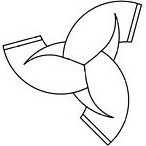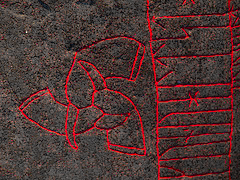 Three interlocked drinking horns is an important Norse Viking symbol. It seems to be closely related the Valknut and Triquetra and is often referred to as the Horn Triskelion. A triskelion (or triskele) is a symbol with threefold rotational symmetry (such symmetry means that a figure, which has it, looks the same after a certain amount of rotation). Translated from Greek the word triskelion means ‘three-legged’. The Horn Triskelion symbolizes Odin: to obtain the mead of poetry (skáldskaparmjöðr) he bargained three nights with the giantess Gunnlöð for three sips of the mead. However, with each sip he drank a whole horn. Since the three horns he drank contained the whole of the mead, Odin thus got all of it and fled in the shape of an eagle.
Three interlocked drinking horns is an important Norse Viking symbol. It seems to be closely related the Valknut and Triquetra and is often referred to as the Horn Triskelion. A triskelion (or triskele) is a symbol with threefold rotational symmetry (such symmetry means that a figure, which has it, looks the same after a certain amount of rotation). Translated from Greek the word triskelion means ‘three-legged’. The Horn Triskelion symbolizes Odin: to obtain the mead of poetry (skáldskaparmjöðr) he bargained three nights with the giantess Gunnlöð for three sips of the mead. However, with each sip he drank a whole horn. Since the three horns he drank contained the whole of the mead, Odin thus got all of it and fled in the shape of an eagle.
The horns’ names were Óðrœrir, Boðn and Són. These three horns contained the mead since the time when the dwarves Fjalar and Galar killed a wise man called Kvasir created from the spittle of Æsir and Vanir. There were no questions Kvasir could not answer. The two dwarves killed him, mixed his blood with honey and poured the beverage into Óðrœrir, Boðn and Són. In Norse Viking mythology the mead of poetry is a symbol of wisdom and poetical inspiration. According to the Prose Edda, whoever drinks it becomes a skald or scholar.
The symbol of the three interlocked horns appears on the Snoldelev rune stone (DR 248). Beside the horns it has an interesting runic inscription:
kunualts stain sunaR
ruhalts þulaR o salhauku
‘Gunnvaldr’s stone, Hróaldr’s son, reciter of Salhaugar’

This inscription uses an early version of the Younger Futhark. The a-rune here has the same form as the h-rune in the Danish variant of the Younger Futhark (Star-rune). The h-rune is from the Elder Futhark rune row. Salhaugar probably refers to modern Salløv, which is not far from the place where the stone was found.
Very interesting is the word þulaR, ‘thul’ or ‘reciter’. It is akin to OE þyle, ‘orator, spokesman’ (the word designated a position of the court associated with Scandinavian and Anglo-Saxon royalty). The ‘thul’ mentioned in the Snoldelev inscription seems to be a dignifying term pointing to a leader, probably a priest, chieftain or law-man. Jan de Vries interpreted thul as a a person who carried with him all the treasure of magical and mythical knowledge. Three horns of Odin, the Norse symbol of wisdom and inspiration, would be an appropriate sign for such an office in the ancient Germanic society.
In modern times the Horn Triskelion is often interpreted as pointing to Norse heathen convictions and sometimes used in Norse Viking tattoo designs.
Photo courtesy Mararie. Used under Creative Commons Attribution-ShareAlike 2.0 Generic Licence.

I love that symbol. It is the one that identifies me and I have it tattooed in sign of all their meanings.it is the maximum thing.
Thank you for sharing this, Max.
Well its on my head now
Hello, I have been looking for the name of a symbol I have seen associated with Vikings at times. It looks like the swastika that is circular and usually placed on shields, only it has three arms instead of four. It wasn’t a triskele but the arms were distributed evenly in the same way as the triskele.
I have also heard that berserkers sometimes tattooed big eyeballs onto the insides of their biceps, so that when they raised their arms above their head with their weapon to strike their enemies, the eyes theoretically struck the fear of heathen into them. I cannot remember where I read this though. Any help would be appreciated. Thanks.
Hello Branden. What you describe reminds me of the symbol adopted by the 27th SS Volunteer Division Langemarck. A similar design was used by Free Corps Denmark.
Well, looks like I won’t be using that symbol at all. Maybe I WAS actually thinking of the treskelion. Although I do wish swastikas were not haunted by nazi usage.
Do you have any knowledge of the eyeball tattoos on the berserkers biceps?
Never heard about them, Branden.
It’s truly sad to see one’s culture and religion perverted in such a way the nazis have done to this one.
Gunlod, Kvasirsdottir.
Lucas, Gunnlöð was a daughter of the giant Suttungr.
Hey I was just wondering where you get all of your information. I’m not questioning you at all, it is clear you know quite a bit but I was just wanting to look into it more myself. Any books or different websites etc…
Thank you! anything would be great
Codi
Hello Codi. What we know about Norse mythology is from the Eddas.
Ok, i am putting runes on my new vodka label ! My son’s name is Odin and interestingly i have found you folks talking about Odin ,and alot more, could you help me with which rune dictionary might be the best to look at, i want words pointing to drink etc , hence even more interested when you taked about poetry and wisdom . Means so much more!
Here’s a little poem I made in Modern English, then translated (using the Old Norse translator and Rune translator on this site) that I plan on having carved, with the Horn triskelion, on a leather flagon I am having made (I am also a mead-maker):
Modern English:
From Mead, Wisdom
From Wisdom, Truth
From Truth, Power
In Mead is Power
Old Norse:
af miði er vísdómr
af vísdómi er sannleiki
af sannleika er kraftr
i miði er kraftr
And yes, I then used the Younger Futhark to translate the Old Norse into runes, for at least an attempt at Viking Age authenticity. Your comments criticisms accepted.
Hello Bjørn. The rune converter does not work with Old Norse texts, as the notification warns right above the input field. It’s for modern English only. For Old Norse texts use the following tutorial instead:
How to Write in Old Norse with Runes
hail to the speakers , hail to the hall , hail thee ancestral wisdom of old & NOW,,,Actually a Viking is a trade NOT a folk group . The symbol is Norse from Scanza and they are not from Viking period per say. As for Star of david I was not referring to that “Sigil of Solomon ” either. Nor is the star a semetic symbol soley either . Dr. John Dees also had the Seals of Solomon/keys . I came across this in the Arcana of freemasonry and others . there are variance of the interlocking pyramid . triple horn is a stylized triskelion by the way . Nor was I saying the valknutr was taken from the East . While the topic of Valknutr is discussed where in “Primary sources not secondary” is this runar/symbol linked , described with thee einherjar ???? I can not find that although it’s always stated as fact…By our Fathers spear first upon our Foes in the Fray of battle , before the charge of Ravens talons .By Gugnir and the Ravens flight…Harson, Son of Lugh , Albie A. Gogel
I wouldn’t agree that Vikings were a trade group. They were people who went to raids. Also, horn triskelion is in fact a Viking Age symbol, since we find it on a Viking Age runestone.
I would like to point out that there are nine worlds. Three symbols of three would indicate nine. In each symbol all the parts are interconnected. This shows that the nine worlds are broken into three groups of three worlds. All the worlds in each group are connected. I have a feeling that when placed on the Tree, they will correspond to the giant lands, the world, and valhalla.
As for Solomon, his symbols deal with the Quintessence. It connects the four elements, the four directions, and binds them with the Energy. Most of his Craft comes from kabalah and greek Crafting. He was reported to have had visitors from all corners of the world, and they would have brought him gifts. These would probably been adorned with symbols of that culture.
I would not be surprissed that a Viking (or group of them) would bring a sword or shield with the Tree, complete with the three symbols.
You have your dates wrong, friend. Solomon lived over 1000 years before the vikings. Probably more like 2000. If the vikings used the same symbols, whether the star of David or anything else, its origin has to belong to Solomon and not the viking culture which existed many centuries later.
Furthermore, I don’t see how the star of David, which is two interposed triangles and made of parts in the quantities 3 or 6, can have anything to do with Quintessence, four elements, or four directions.
The vikings themselves were not around for long however Northern European culture has been around for a very long time and people in Europe existed there as far back as 44,000 years so far as we know
However, Indo-Europeans came to Europe as late as in 3100-2500 BCE (Corded Ware culture).
Hallo,
ich suche schon eine ewigkeit, das symbol der valkyrien, (flügel) oder eine schönes motiv, da ich mich selber zum 45 geburtstag mit einen Tattoo beschenken will, helft mir
danke im Voraus !!!!
Hallo Axel,
Sie können das Symbol der Valkyrien hier finden.
On the 3 drinking Horns or the Valknot , wich is 3 pyramids or triangles. This is also the legendary seal of Solomon, really it is. I found this out in the last few months. I am unsure of the significance of this and how and when this symbol was shared. There are a couple seals/ sigils of King Solomon, the one most are familiar with is the Tetragramaton, but the Valknot is definately it.
May the blessings of the Harvest be with you and your loved ones. May we all share in the bounty of Har’s quest. Megi Othin Blessi Thig,
Albie
Hi Albie,
This is interesting, thank you.
Hey, Solomon’s seal was actually a Star of David that was made of two interlocking triangles not three like a Valknut is.
Gibu Auja
A horn is not a triangle, nor is it a pyramid. It is a spiral, it has a curve, an arc. Triangles, pyramids and spirals are all completely different things.